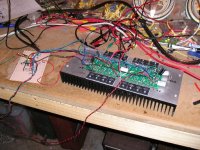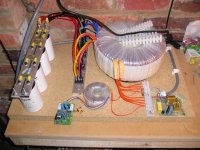ilimzn said:Interestingly most array BJTs also show rather high input capacitances, similar to MOSFETs (this is very rarely talked about, strangely enough).
Ilimzn,
When will that be a problem for complimentary PP designs ?
jacco vermeulen said:
Ilimzn,
When will that be a problem for complimentary PP designs ?
With well designed driver stages, of course, the problem is minimized, but consider the amp in the 'Brother of Quasi' thread. This is a 'quasi' with BJT output stages, and in this application, the highish Cbc is equally of concern as Cdg is with MOSFETs. This type of topology actually seems to appear quite rarely with BJTs but it exposes a consideration which can rear it's ugly head in much more common configurations, namely ones that offer 'unlimited' current for charging the capacitance but limited current for discharging it - or vice versa. Some that come to mind are CFPs and the classical darlington.
IMHO MOSFETs tend to be viewed in a negative light due to their high gate capacitance, but if you think about it, it's most often because designers tend to avoid a driver stage after the VAS in MOSFET designs - something that you usually can't do with BJT designs - that exposes the consequence of these capacitances being high.
ilimzn said:
Also using current sources would improve performance somewhat, but it sadly leaves you with indeterminate DC conditions. MOSFET amp performance tends to improve when more current is available to charge and discharge the capacitances, the only problem is you end up with driver stages that could almost drive the output themselves if you go too far
The better solution is to find better MOSFETs
Yesterday working on an amp for a condencer microphone I thought that we are unhappy because we don't have an active device with capacitive output!
Here is something you guys might be interested in, my current design I am working on. A 2kw into 4 Ohms Grounded Bridge Amp using N-channel laterals Mosfets.
With the current power supply I am using I am getting 1kw into 8 Ohms and about 1800 watts into 4 Ohms.
With the current power supply I am using I am getting 1kw into 8 Ohms and about 1800 watts into 4 Ohms.
Attachments
Stove Recepticle
You are a strange and wonderful person. Did you grow up hanging around arc welding machinery? Do you dream of enthusiasts buying amplifiers that require electric stove connectors?
Do you dream of enthusiasts buying amplifiers that require electric stove connectors?
Cheers to you and your work!
Shawn.
The Saint said:Here is something you guys might be interested in, my current design I am working on. A 2kw into 4 Ohms Grounded Bridge Amp using N-channel laterals Mosfets.
With the current power supply I am using I am getting 1kw into 8 Ohms and about 1800 watts into 4 Ohms.
Here is the Power Supply
4KVA Transformer with 4 x 4700uf 250v caps and 4 x Bridges
An overkill I knowBut O'Well
You are a strange and wonderful person. Did you grow up hanging around arc welding machinery?
Cheers to you and your work!
Shawn.
The Saint said:Here is the Power Supply
4KVA Transformer with 4 x 4700uf 250v caps and 4 x Bridges
An overkill I knowBut O'Well
Good source for Class A monoblock!
The Saint said:Here is the Power Supply
4KVA Transformer with 4 x 4700uf 250v caps and 4 x Bridges
An overkill I knowBut O'Well
4kVA ???? that's about half of Tassie's grid !!!
Cheers
Q
Hi Quasi
I must say when I turn up the wick on this amp it does tax my standard 10A workshop GPO.
The mains supply drops by about 6 Volts AC from 246VAC at full power. Just think what it would do with 2 Channels running...
Shawn you would be surprised at the amount of people out there that want 2kw Amps.
I just love big powerful amplifiers.... I guess I am a bit strange. LOL.
The sound quality from this amplifier is surprisingly very good.
I have some Samples from NSC of the new LM4562 opamp, I will have to give them a try in this amplifier....
This current design is for a commercial amplifier that my UK partner and I are developing. It will ultimately be matched with one of www.class-d.com SMPS
I may have to get the electrician to put a more powerful GPO in my workshop
I must say when I turn up the wick on this amp it does tax my standard 10A workshop GPO.
The mains supply drops by about 6 Volts AC from 246VAC at full power. Just think what it would do with 2 Channels running...

Shawn you would be surprised at the amount of people out there that want 2kw Amps.
I just love big powerful amplifiers.... I guess I am a bit strange. LOL.
The sound quality from this amplifier is surprisingly very good.
I have some Samples from NSC of the new LM4562 opamp, I will have to give them a try in this amplifier....
This current design is for a commercial amplifier that my UK partner and I are developing. It will ultimately be matched with one of www.class-d.com SMPS
I may have to get the electrician to put a more powerful GPO in my workshop
Thanks, but unfortunately the figures are only right for a given manufacturer of MOSFETs.
I have just checked how various types of MOSFETs with the same designation differ across manufacturers.
Here is a small comparison: Fairchild IRFP240 has 160pF Cdg, while IRF IRFP240 has 130pF. Cgs is more or less the same. However, with the IRFP450, things canbe DRASTICALLY different. ST IRFP450 has Cgd only 40pF, while IRF IRFP450 has 340pF - a factor of 8.5 times larger!!! To make matters worse, it's gm is also higher, 17A/V at 11A vs 15A/V for the ST version.
Using these figures, replacing IRF IRFP450 with IRF IRFP240 is not only possible, but highly recomended!!!
In any case, it is clear from my first post that reducing Cgd (also known as Crss) is af high importance for quasicomplementary amps, including your design. Sometimes chosing the manufacturer of a supposedly equivalent part may be the key to achieving this goal.
In that case, is it OK to use SiHG22N60E from Vishay? Crss is only 6pF!
http://www.vishay.com/docs/91473/sihg22n60e.pdf
- Status
- This old topic is closed. If you want to reopen this topic, contact a moderator using the "Report Post" button.
- Home
- Amplifiers
- Solid State
- A.Holton AV400 using irfp or Quasi mosfet amplifier ?

